

The Step Sequencer is the main part of FruityLoops' interface. It contains a button for each channel in your song, from which you can call its Channels Settings, Piano Roll etc. It also contains a pattern grid, where you can create drum loops and simple melodies.


Each line in the Step Sequencer represents a single channel with its pattern dots. Each dot represents a 16-th note. The default pattern length is 16 dots, but you may change this setting from the Song Settings window. Left-clicking a dot turns it on; right-clicking turns it off. Note that if you have turned off Use Both Mouse Keys option in the General Settings page, left-clicking turns both on and off a dot. You can also set the pitch of dots using the Keyboard Editor view. Each note has some additional properties (panning, volume etc.) that you can set using the Graph Editor view. Right-clicking the Channel Button (10) brings up a menu that provides some commands for managing channels (see Channel Menu). This menu also provides access to the Piano Roll window that lets you create much more complex melodies than using the Step Sequencer's grid. The main Edit menu also contains commands for working with Step Sequencer.
Having too much channels makes working in the Step Sequencer slow and tedious. In FruityLoops 3.4 and later you can combine several channels in a group and set the Step Sequencer to display only specific group of channels (for example percussion group or lead synth group). To control which channels should be visible you can use the Channel Display Filter control (6). Left-click to open the channel filter menu. Selecting "All" shows all channels at once, no matter if they are part of any group or unassigned. Selecting "Unsorted" displayed only the unassigned channels. Also, if you have made any channel groups, you can select them for display from this menu. To add empty group, right-click and select Add Filter Group. With the group displayed, right-click the Channel Display Filter control to see commands for renaming and deleting a group (deleting a group won't delete the channels in it, but make them unassigned). To add all selected channels to a group, use the Group Selected command from the Channels menu.
When adding new channels, they go in the currently selected group.